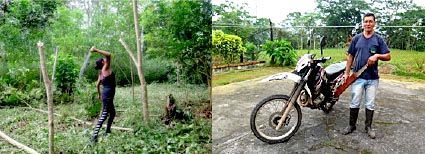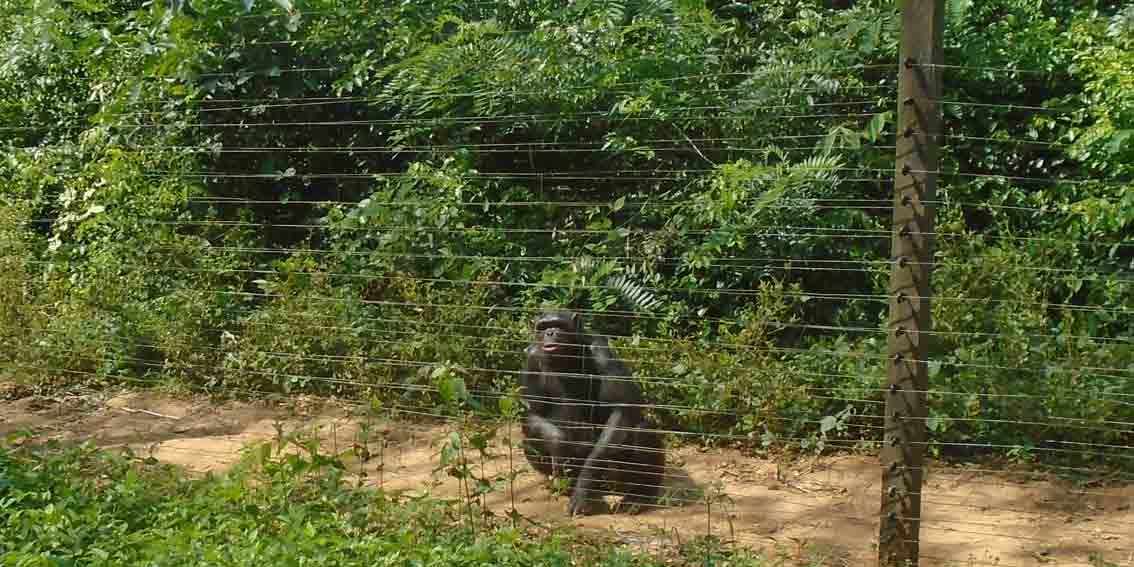Ecuador Happenings in Pictures (March-April 2021)
By Antony Melville and Nicola Peel | Newsletter No. 108
A lot has been happening in Ecuador. Here are some highlights.
THE TEAM:

Nathaly Grefa (left – pruning an Inga plot) from the Amazon University is regularly supporting Jose Fernandez (right), our farm co-ordinator – giving presentations, doing soil analysis, and measuring carbon.
BIOCHAR:
Under Nathaly’s guidance, we are now making biochar with the wood from the prunings

This is small pieces of charcoal, the fire doused with water rather than smothered as with charcoal for burning; this charcoal is incorporated into the soil where is becomes a carbon sink, but stimulates fertility by providing huge amounts of surface for micro-orgaisms to live on. It is also very porous and holds moisture in the soil.
COMPARISON PLOTS:
We have 4 sites so far set up for comparison tests to compare the yield from the Inga alley with a control plot outside (same seed, same day etc) .
First up Maize:

From the college site at Shushfindi – cobs from the Inga plot are 3 x the size of those from outside

But maybe more interesting, this plot belonging to Angel Encarnacion, produced nothing at all; the Inga was very slow to grow, and after the first pruning the maize came up, but produced no cobs. At the second pruning the trees produced 3 times as much mulch as the first time, and the maize sown in the alleys produced a crop (pictured here), while the control sowing produced nothing at all. This is coming up from a very low level of fertility.
Then Cassava:
We have 3 plots with comparisons of cassava, planted in May and June last year, so the harvest will start around June this year.

Cassava comparison at Amilcar Pinzon’s : left – thin plants 2.5m tall inside alley; right straggly plant 1.5m tall outside – Jan 2021. As of March all are flowering – harvest is expected in June once the seed has set and dried.

HEADING FOR THE MOUNTAINS
We have our first plot at over 1800 m above sea level.

This site has fish ponds, and grows orchids for sale (right) ; they have a lot of primary forest, and pan for gold in the river. And here they are sowing the first Inga seeds in November – now 10cm. tall in March (very slow).

But next door is a local species of Inga, which Jose has pruned for a test – in March it has a bud. We need to see flowers to identify the species.


SHUAR PEOPLE AND BEANS
Meanwhile the Shuar people have done a community prune on their Inga plot (left) and sown medicinal herbs (right)

They have planted 3 varieties of bean, and just cut back the Inga leaves to stop the beans being shaded:

The beans, supported on the Inga, are winning!
COCOA
We have fantastic results with Cocoa grown in the alleys – beautiful healthy fast-growing plants, flowering and fruiting while the plants outside are yellowish and small and not flowering. Since many local cocoa famers are being defeated by an endemic fungal rot “pod rot” (moniliophthora), and the ones in the alleys show no sign of it, we are keen to research the resistance, and are talking to the Cocoa team at Reading University about a possible PhD on the subject.

And back to CASSAVA
While we wait for results from the comparisons with control plots, Jose has harvested from his Inga plot a record Cassava root weighing in at 39 Lbs, where before the Inga he would get about 12 Lbs.

Thanks for your support!
Antony and Nicola
If you would like to contact the authors of any of the articles please click reply, indicating whether it is for publication or not. We will be happy to publish your letter and/or forward it to the author, whichever you request. We hope to bring you a monthly or bimonthly newsletter with articles of interest on topics relevant not only to Inga alley cropping, but also some of more general interest, particularly articles relevant to rainforests, agroforestry and sustainable farming in general.














